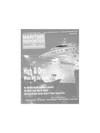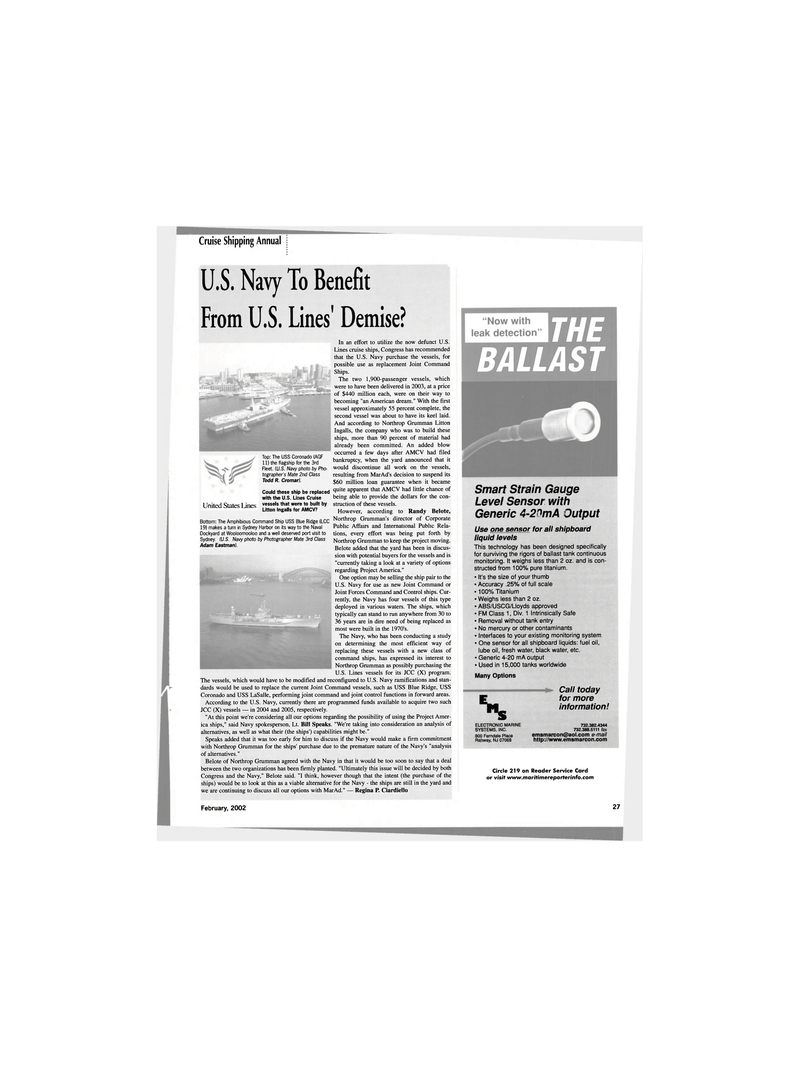
Page 27: of Maritime Reporter Magazine (February 2002)
Read this page in Pdf, Flash or Html5 edition of February 2002 Maritime Reporter Magazine
Cruise Shipping Annual
U.S. Navy To Benefit
From U.S. Lines' Demise?
Top: The USS Coronado (AGF 11) the flagship for the 3rd
Fleet. (U.S. Navy photo by Pho- tographer's Mate 2nd Class
Todd R. Cromar).
In an effort to utilize the now defunct U.S.
Lines cruise ships, Congress has recommended that the U.S. Navy purchase the vessels, for possible use as replacement Joint Command
Ships.
The two 1,900-passenger vessels, which were to have been delivered in 2003, at a price of $440 million each, were on their way to becoming "an American dream." With the first vessel approximately 55 percent complete, the second vessel was about to have its keel laid.
And according to Northrop Grumman Litton
Ingalls, the company who was to build these ships, more than 90 percent of material had already been committed. An added blow occurred a few days after AMCV had filed bankruptcy, when the yard announced that it would discontinue all work on the vessels, resulting from MarAd's decision to suspend its $60 million loan guarantee when it became
United States Lines
Could these ship be replaced 1uite apparent that AMCV had little chance of with the U.S. Lines Cruise being able to provide the dollars for the con- vessels that were to built by struction of these vessels.
Litton Ingalls for AMCV? However, according to Randy Belote,
Bottom: The Amphibious Command Ship USS Blue Ridge (LCC NorthroP Grumman's director of Corporate 19) makes a turn in Sydney Harbor on its way to the Naval Public Affairs and International Public Rela-
Dockyard at Wooloomooloo and a well deserved port visit to tions, every effort was being put forth by
Sydney. (U.S. Navy photo by Photographer Mate 3rd Class Northrop Grumman to keep the project moving.
Adam Eastman). Belote added that the yard has been in discus- sion with potential buyers for the vessels and is "currently taking a look at a variety of options regarding Project America."
One option may be selling the ship pair to the
U.S. Navy for use as new Joint Command or
Joint Forces Command and Control ships. Cur- rently, the Navy has four vessels of this type deployed in various waters. The ships, which typically can stand to run anywhere from 30 to 36 years are in dire need of being replaced as most were built in the 1970's.
The Navy, who has been conducting a study on determining the most efficient way of replacing these vessels with a new class of command ships, has expressed its interest to
Northrop Grumman as possibly purchasing the
U.S. Lines vessels for its JCC (X) program.
The vessels, which would have to be modified and reconfigured to U.S. Navy ramifications and stan- dards would be used to replace the current Joint Command vessels, such as USS Blue Ridge, USS
Coronado and USS LaSalle, performing joint command and joint control functions in forward areas.
According to the U.S. Navy, currently there are programmed funds available to acquire two such
JCC (X) vessels — in 2004 and 2005, respectively. "At this point we're considering all our options regarding the possibility of using the Project Amer- ica ships," said Navy spokesperson, Lt. Bill Speaks. "We're taking into consideration an analysis of alternatives, as well as what their (the ships') capabilities might be."
Speaks added that it was too early for him to discuss if the Navy would make a firm commitment with Northrop Grumman for the ships' purchase due to the premature nature of the Navy's "analysis of alternatives."
Belote of Northrop Grumman agreed with the Navy in that it would be too soon to say that a deal between the two organizations has been firmly planted. "Ultimately this issue will be decided by both
Congress and the Navy," Belote said. "I think, however though that the intent (the purchase of the ships) would be to look at this as a viable alternative for the Navy - the ships are still in the yard and we are continuing to discuss all our options with MarAd." — Regina P. Ciardiello
Smart Strain Gauge
Level Sensor with
Generic 4-20mA Output
Use one sensor for all shipboard liquid levels
This technology has been designed specifically for surviving the rigors of ballast tank continuous monitoring. It weighs less than 2 oz. and is con- structed from 100% pure titanium. • It's the size of your thumb • Accuracy .25% of full scale • 100% Titanium • Weighs less than 2 oz. • ABS/USCG/Lloyds approved • FM Class 1, Div. 1 Intrinsically Safe • Removal without tank entry • No mercury or other contaminants • Interfaces to your existing monitoring system • One sensor for all shipboard liquids: fuel oil, lube oil, fresh water, black water, etc. • Generic 4-20 mA output • Used in 15,000 tanks worldwide
Many Options
S
ELECTRONIC MARINE
SYSTEMS, INC. 800 Ferndale Place
Rahway, NJ 07065
Call today for more information! 732.382.4344 732.388.5111 fax [email protected] e-mail http://www.emsmarcon.com
Circle 219 on Reader Service Card or visit www.maritimereporterinfo.com
February, 2002 27

 26
26

 28
28
